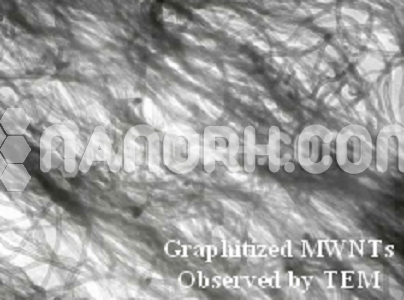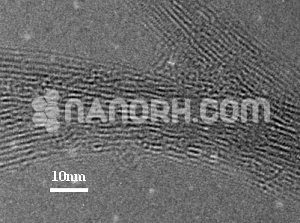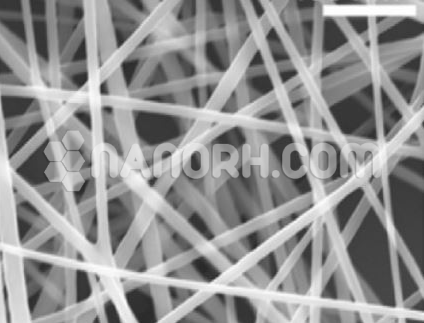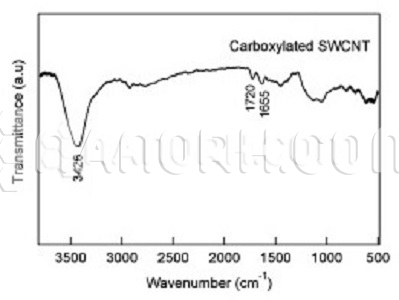OH Functionalized Graphitized MWNTs (>99.9%, OD: 20-30nm)
Graphitized high purity multi-walled carbon nanotubes (MWNTs) were produced by a low temperature CVD method and subsequently annealed about twenty (20) hours under condition of inert gas at temperatures between 1600 and 3000°C. These products were characterized for chemical purity, interlayer spacing, and defect healing. The graphitization procedure was found to remove residual metal catalyst in the nanotubes and reduce the wall defects as reflected in a reduced interlayer spacing between the graphene shells. The graphitized MWNTs have the highest graphite crystallization, the high electrical conductivity and the excellent inoxidizability. The electrical conductivity of the graphitized MWNTs is very close to that of graphite powder. And its ignition temperature can reach 800°C.
| OH Functionalized Graphitized MWNTs | |
| Product No | NRE-40008 |
| CAS No. | NA |
| Purity | Carbon nanotubes > 99.9wt% |
| Average Diameter | 20-30 nm |
| Average Length | 10-30 um (TEM) |
| Special Surface Area(SSA) | >55m2/g(BET) |
| Tap Density | NA |
| True Density | 2.1g/cm3 |
| Electric Conductivity | > 100 S/cm |
OH Functionalized Graphitized MWNTs
OH-functionalized graphitized MWNTs represent a highly specialized form of carbon nanotubes that have undergone two key processes: graphitization and hydroxyl functionalization.
Applications
Composite Materials
Polymer Nanocomposites: OH-functionalized MWNTs are widely used to enhance the mechanical and electrical properties of polymer matrices. The functionalization improves the dispersion of MWNTs within the polymer, leading to better reinforcement and performance. Applications include:
Automotive and aerospace components (lightweight, high-strength materials).
Sports equipment (e.g., tennis rackets, bicycles) for improved strength-to-weight ratio.
Electrical and thermal management materials, such as conductive adhesives and thermal interface materials (TIMs).
Conductive Composites: By improving the dispersibility and conductivity of MWNTs, OH-functionalization aids the development of composites for use in electrical devices. Examples include:
Supercapacitors and batteries, where high conductivity and surface area are important for charge storage.
Electromagnetic shielding materials to protect sensitive electronics from EMI.
Energy Storage and Conversion
Supercapacitors: OH-functionalized graphitized MWNTs are used as electrode materials in supercapacitors. The enhanced dispersibility and electrochemical performance of these MWNTs allow supercapacitors to store more energy and have better charge/discharge rates. They are commonly used in:
Electric vehicles (EVs).
Portable electronics.
Energy storage systems (e.g., for renewable energy sources like solar or wind).
Lithium-Ion Batteries: The enhanced conductivity and cycle stability of OH-functionalized MWNTs make them ideal for use in the anode or cathode materials of lithium-ion batteries. These batteries are used in:
Electric vehicles (EVs).
Consumer electronics (smartphones, laptops, etc.).
Grid storage systems for renewable energy.
Fuel Cells: OH-functionalized MWNTs serve as catalyst supports in proton exchange membrane fuel cells (PEMFCs). Their high surface area and reactivity improve the catalytic efficiency of fuel cells, which are used in:
Hydrogen-powered vehicles.
Portable power sources.
Backup power systems.
Electronics and Nanoelectronics
Carbon Nanotube Field-Effect Transistors (CNT-FETs): OH-functionalized MWNTs are used in the development of CNT-FETs for nanoelectronics. The hydroxyl groups improve the electrical performance and stability of the transistors, which can be used in:
Flexible electronics, such as wearable devices or e-textiles.
High-speed processors for advanced computing.
Electromagnetic Interference (EMI) Shielding: OH-functionalized MWNTs are used in EMI shielding materials to protect sensitive electronic equipment from external electromagnetic interference. These materials are crucial in:
Consumer electronics (e.g., smartphones, laptops).
Medical devices that require protection from interference.
Military and aerospace electronics.
Transparent Conductive Films: The hydroxyl groups enhance the dispersion of MWNTs in polymer matrices, which can be used to produce transparent conductive films for:
Touchscreens, OLED displays, and solar cells.




